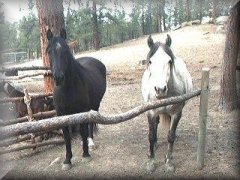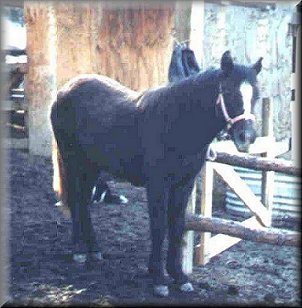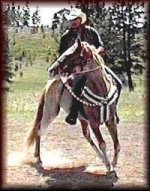
![]()
![]()

Midnight
and Angel looking to get some attention.
These
two, as well as Little Durango are very
people
friendly. They will come right up to you
as soon
as they see you to see what kind of
goodies
you might have stashed in your pockets.

Are we
gonna go ridin or sumpin?
![]()

Durango
on his first day at our
humble
little ranch!

Gettin
ta know ya!

Here
is "Angel" at nine months old,
back
when she was a "Blue Roan" color.
Now she
is considered a Gray,
but will
probably turn white eventually!
She is
quite an entertaining companion!

"Cowboy
Up"
This
is the first time Angel ever had a saddle on her
and all
she did was turn her head and nibble my knee.
I am
not complaining about the lack of a rocket ride,
but I
was geared up for at least a crow hop or two!
She is
a very gentle and sweet horse.

Winter
Ride

Angel
and I clowning
around
as usual.
![]()

Partners!
![]()
![]()
![]()

Medical Tip for the Trail
If injured,
a horse can lose up to four to five gallons of
blood
before they are in any danger. Always keep a medical kit in your saddle
bag that can accommodate your horse, as well as yourself. I carry a large
styptic pencil, which you can buy in any drug store, as this is a good
tool to slow down or stop any bleeding. Also carry a sheet of cotton and
a roll or two of gauze wrap. A couple of rolls of latex leg wraps work
better than tape to finish off any bandaging you might have to do. It is
also a good idea to carry some Banamine paste, a small bottle of Scarlet
oil, peroxide, Bute paste, and some *rubber tubing. All of these supplies
fit perfectly in one side of a small saddlebag. Carry a canteen of water
if your ride is a long one, as it is not only for drinking but for cleaning
out wounds as well. if your horse becomes injured do not panic and run
your horse back to your destination, they will make it at a nice slow walk.
Do not
ride them if they have a pronounced limp,
walk
with them and keep them calm.
I am
not an expert, but I know what works!
If you
have any other ideas, please email them to me,
as I
always like to hear from others about how they
handle
their own trail emergencies.
*If bitten
by a rattlesnake on the nose or mouth area.
Rubber
tubing should be cut into two pieces of equal length and placed into the
animals nostrils. This will keep the air passages open and facilitate breathing.
|
Ranch |



